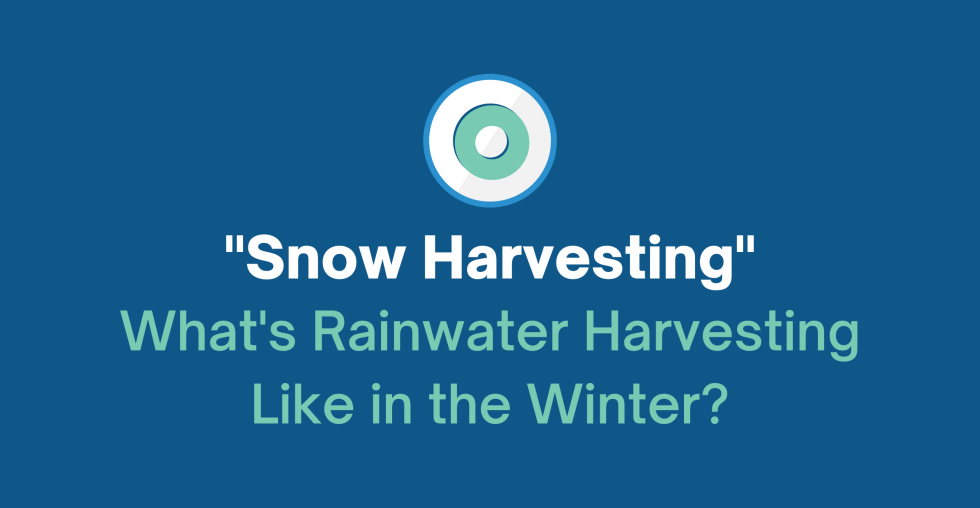What is Rainwater Harvesting Like in The Winter?

Rainwater harvesting is a growing trend that is better for the environment and gives homeowners more freedom over their water source. While rainwater harvesting makes sense in areas where precipitation stays liquid all year, some may wonder if it is viable in the Northern half of the country when water turns to snow. The short answer is yes; it is absolutely possible to harvest water in the winter months.
Basics of Rainwater Harvesting
Understanding snow water harvesting helps to have a general idea about how rainwater harvesting works. It all starts when rain hits your roof and flows down to the gutters. The gutters guide the water to a catchment system where the water is filtered for large debris and then stored in tanks that are buried, partially buried, or above ground. Then, when water is needed, a pump pushes the water through a multi-stage filtration unit and into the house.
How Does Rainwater Harvesting Work in the Winter?
When you think of winter, it conjures images of frozen snow and ice, and while that is true for the most part, people don't realize that snow will still melt even in the cold. Your roof has a large surface area for the sun's rays to hit, so heat from the sun, even in the winter, will slowly melt the snow from your roof, which will then go through the traditional rainwater harvesting process. In addition, your home gives off heat which also aids in the heating process, so even if you can't see the snow melting, some water is moving underneath.
It is also essential to remember that your water tanks are not empty when things start to freeze, so it is unlikely you will need the snow to melt quickly to fill your tanks. Your stored water will likely be plenty to get you through the coldest weeks of winter when the temperatures are at their lowest. In the unlikely scenario of not getting enough water from the snow melt, our system allows you to temporarily switch to another water source like city or well water, or manually fill the tanks with an outside water source.
Will the Water in my Tank Freeze?
One of the most critical questions is whether the water in your storage tank will freeze and what happens to the water in your pipes. The easiest way to ensure your water tanks will never freeze is to choose underground tanks. The ground beneath the topsoil and 20 - 30 inches below the surface averages about 55 degrees Fahrenheit, no matter the air temperature. Above-ground tanks do have the potential to freeze slightly, but this is usually only the first few inches, so the ice doesn't reach the pump in the center of the tank, and no part of the system operation is affected by the ice. Partially buried tanks will likely see the benefits of the ground temperature as well but could also see the same freezing pattern as above-ground tanks in frigid climates.
The pipes leading to the house will likely be underground, enjoying that 55-degree average temperature, but if, for any reason, your pipes have to be above ground, they can be fitted with insulation to prevent them from freezing. It is unlikely that water harvesting pipes would ever freeze because it would take six to eight hours of consistent temperature below freezing without water movement for those pipes to freeze.
Snow Melting Options
If you are still worried about the amount of water you can collect from snow, consider these ideas to help the melting process.
Get Rid of Excess Snow
One of the easiest ways to ensure good snow melt is to eliminate excess snow on your roof by brushing it off, allowing the combination of the sun and your home's heat to melt the thin layer of ice and snow.
Heat Coils
If you are truly worried about having enough water to last the winter and live in an area where the weather stays cold for long periods, you may want to invest in heat coils for the roof that will melt the snow and provide you with ample amounts of water.
Heat the Attic
Although attics are not as common as they once were, some homes still have rooms just below their roof. One way that you can try to increase snow melt from your roof is by heating your attic. This should only be done if it is an actual room; many homes today have small crawl spaces for ductwork and insulation, and trying to heat those spaces is a fire hazard.
Add Hot Water
Using water to create water may seem counter-productive, but you can increase snow melt by pouring hot water on your roof to melt the snow. All the water you pour will make its way back to your reservoir, so you are not losing any water; however, this is another emergency option since it won't create that much new water.
The Benefit of Snow Harvesting
While harvesting rainwater is the most direct and efficient method, there is one benefit of harvesting water from snow. When it rains, you only get the water from that single rainstorm; if your tanks are already filled, they will spill over. Snow can accumulate on your roof over time and stay on your roof all season, so essentially you have a backup source of water even if your tanks are already full. Aside from that, harvesting water from snow is the same as harvesting rainwater.
Do I Need to Worry About Snow Contaminants?
The one downside to snowmelt from the roof is that the longer it sits on the roof, the more chance it has to come in contact with natural contaminants. The great news is that our water harvesting system is prepared to handle anything nature can throw at it. First, when the snow melts, it will be filtered before it ever reaches the tank to prevent large contaminants like sticks and leaves from entering the tank. Then, when the water is pumped to the house, it goes through another filtration process that removes microscopic organisms and bacteria from your water. As a result, the water that flows into your house from your harvesting system is purer than water you would get from traditional sources.
It Works in All Climates
No matter where you live in the country, our rainwater harvesting system is ideally suited to function at one hundred percent throughout the year. If you're interested, schedule an appointment with a rainwater specialist today!
Ready to Take Control of Your Water Supply?
Don’t wait for water shortages or unreliable sources to disrupt your life. With our Rainwater Harvesting systems, you can enjoy a sustainable, reliable, and completely self-sufficient water solution tailored to your home’s needs.

